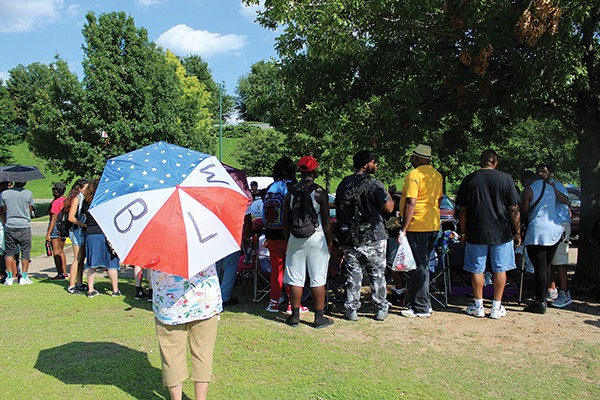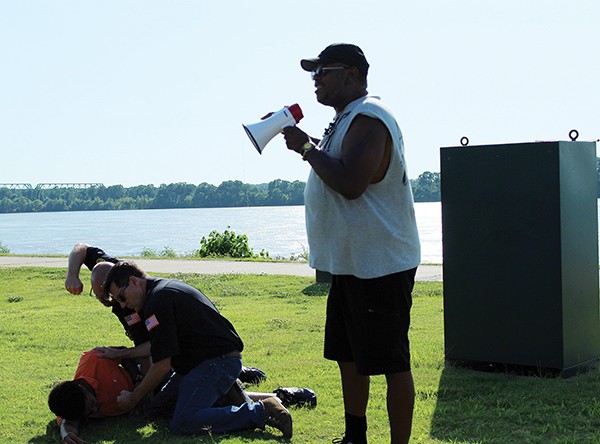It seems like lately the hamburger is taking up a larger chunk of our culinary landscape. Why is that?
John T. Edge is the director of the Southern Foodways Alliance and author of the recently released Potlikker Papers. But, more importantly for our purposes, he is the muse behind Hog & Hominy’s John T. Edge Burger, which was named best burger in the country by Food & Wine last spring.
In 2005, he published a book titled Hamburger & Fries, one in a series that included Fried Chicken and Apple Pie.
Edge had an inkling of the coming burger wave when he was writing his 2005 book, but he couldn’t quite put his finger on it then. “I think it’s been building. I saw the beginnings of it in the early 2000s. There’s a way to pin that to 9/11 and the aftermath of 9/11 and a deepening appreciation of the American vernacular food. It’s not just hamburgers; it’s fried chicken; it’s apple pie,” he says. “All of those singular American foods we’ve come to appreciate. And I think in this political divisive moment we live in now, you can extend that out to iconic American food — that in a moment when it’s difficult to take pride in our political leaders, you can take pride in our cultural creations, and one of our singular cultural creations is the hamburger.”
It’s Burger Week, y’all. The Flyer has teamed up with 15 local restaurants for a $5 burger deal. $5! You can’t beat that. Check out the Burger Week spread on page 20, or go to memphisflyerburgerweek.com for all the details.
In the spirit of Burger Week, we dedicate the cover space to some of Memphis’ most iconic hamburgers. Enjoy, and go eat you a burger. — Susan Ellis
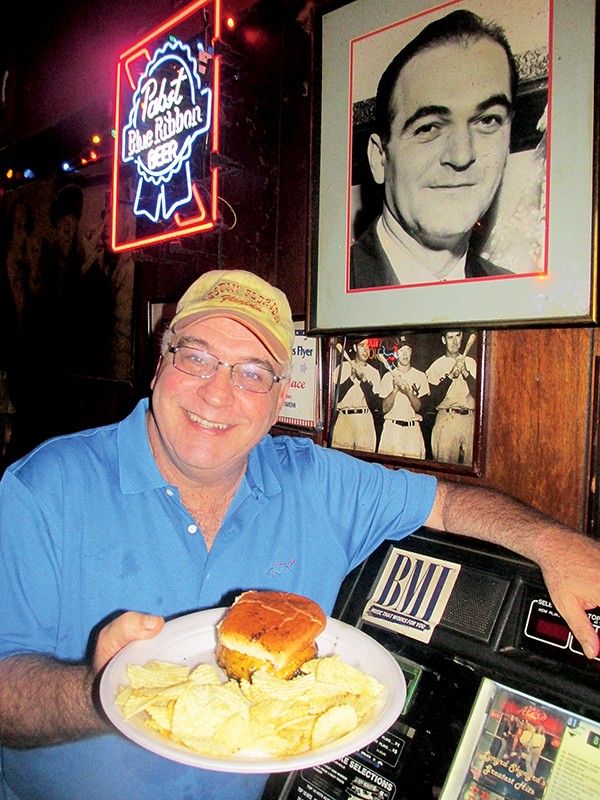
Rocky Kasaftes
The Greek Burger
His dad, Alex Kasaftes, served “a great ham sandwich” when he opened Alex’s Tavern in 1953, says Alex’s son, Rocky Kasaftes. “My mom would cook the ham at home in the oven. Maybe use brown sugar, Coca-Cola, and cloves,” he says. “Daddy would bring the ham over here and set it in a rack. He would slice the ham off the rack.”
Alex eventually sold hamburgers. Rocky’s mom, Eugenia, also sold hamburgers when she owned Highpoint Grill, the fore-runner to High Point Pub.
Rocky and his mom began serving hamburgers in the mid-’70s at Alex’s Tavern, but Rocky, who now owns Alex’s, soon made the burgers his own. “Someone brought me a thing of Cavender’s, the Greek seasoning.” He began using Cavender’s on the burgers as well as a “special kind of pepper, too. Not regular pepper. Seasoned pepper.”
Rocky likes to cook his burgers in a skillet. “When it’s almost done, I put that cake dome on top of it. It kind of steams that cheese.”
Rocky’s hamburger has had a few names over the years. “They used to call it the ‘Alex Burger.’ The ‘Rocky Burger.’ I like the ‘Greek Burger’ ’cause we’re Greek. That’s what’s in the window. That’s what I like. In respect to mom and dad.” — Michael Donahue
Alex’s Tavern, 1445 Jackson, 278-9086
Huey Burger
You want to know how to make a good burger? There’s no better person to ask than Jimmy Lee, general manager of Huey’s Germantown. Lee’s been with the company for 20 years — about the length of time Huey’s has been dominating the burger category in the Memphis Flyer Best of Memphis polls.
Huey’s famous hamburger got its start in the early 1970s while Thomas Boggs was still just a bartender in Midtown. “John Gray’s Big Star was right around the corner on McLean,” says Lee. “There wasn’t much on the menu back then, but they did do a burger. Our kitchen manager in Midtown, Terry Gant, would walk over to John Gray’s meat market with a shopping cart and buy ground chuck. He would patty up the burgers by hand. Then the company developed our special seasoning. … The meat that we’re buying today is certified Angus beef, which is better than what we were using back then. But the way we cook and season the burgers has remained largely unchanged in the last 40-plus years.”
Boggs would eventually buy the business and, with his partner Jay Sheffield, build the little dive into an iconic regional franchise. “We don’t mash the burgers. That was one of the things Thomas Boggs taught us. It’s a major taboo. It squeezes all the juices out.”
In addition to the classic Huey Burger, a number of specialty burgers have cropped up on the menu in recent years. New topping combinations, such as the West Coast’s guacamole and Monterey Jack combo, are developed by Huey’s employees in periodic, in-house contests. Huey’s Burger Week contribution, the Bluez 57 Burger, came out of one such contest. — Chris McCoy
Huey’s, multiple locations, hueyburger.com
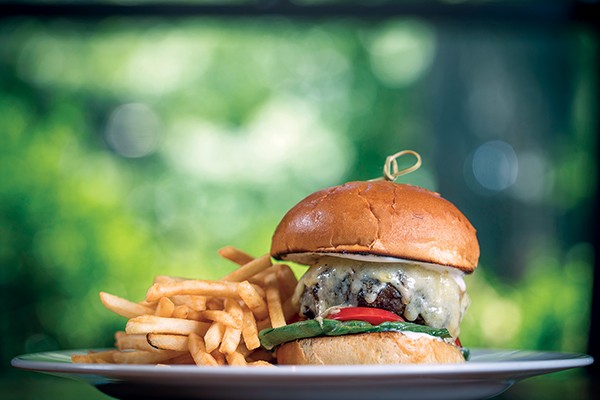 Justin Fox Burks
Justin Fox Burks
Acre Burger
Acre Burger
Why are so many restaurants — upscale and otherwise — creating such fantastical burgers these days? Who’s responsible for this gourmet burger trend that’s sweeping the country? Why, Memphis restaurateur Wally Joe, of course.
Not really, but the affable owner-chef at Acre restaurant does joke that some of his chef friends have pinpointed the beginning of the over-the-top burger craze with the cheeseburger that Joe created circa-2003 for his former restaurant, Wally Joe’s.
“Fredric Koeppel of the CA wrote about it, and it just took off,” Joe remembers.
And it does sound pretty good.
“We used trimmings from in-house, dry-aged ribeyes for the meat,” Joe says. “We created a house-made horseradish brioche bun, added black truffle cheese and tomato confit, and served it with hand-cut fries.”
Wally Joe knows a thing or two about great food. He’s been cooking since he was a kid, beginning at his family’s restaurant, KC’s, in Cleveland, Mississippi, back in the mid-1990s. He was the first Mississippi chef ever invited to cook at the famed James Beard House and is a master of several types of cuisine.
So what makes a great burger?
“The most important thing is that it can’t be lean beef,” Joe says. “You want about an 80 percent lean/20 percent fat ratio. Ground chuck is probably the perfect beef for a good, home-cooked burger.”
And what kind of burger does Joe serve now at Acre? “Just your basic burger — good beef grilled to order, aged cheddar, lettuce, tomato, horseradish. What’s more all-American than a burger?” — Bruce VanWyngarden
Acre, 690 S. Perkins, 818-2273, acrememphis.com
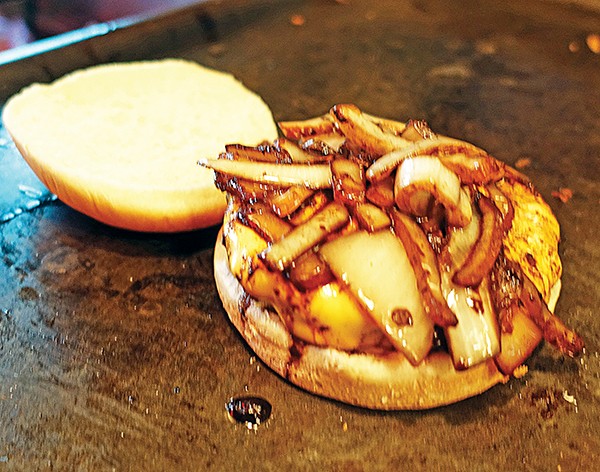
The Soul Burger
Soul Burger
Earnestine & Hazel’s, the weathered but somehow elegant dive at the northwest corner of South Main and G.E. Patterson, one of several bistros in the stable of legendary folk restaurateur Bud Chittom, fairly drips with grease, spice, and history.
So does the Soul Burger, the basic but well-layered hamburger that has been devoured many thousands of times over by Memphians and tourists, the famous and unfamous alike, since the establishment, once upon a time a church, then a pharmacy (owned by Abe Plough), then a bordello (run by the eponymous ladies of the current establishment’s name) became a restaurant for good in 1992, thanks to Russell George.
George offered one specialty, the Soul Burger, and that, served with packages of chips and washed down with sodas or beer, is still the staple meal, one that’s been dubbed a classic in connoisseurs’ journals around the world. Cooked on a long tabletop grill that’s decades old, the Soul Burger starts out with mayonnaise and mustard mixed on the bottom half of a bun, then gets a well-done beef patty still oozing its own natural grease, pickles are added, shortly to be topped by a layer of cheese, then a succulent pile of thoroughly grilled onions, and finally doused in a spicy “Soul Sauce” made according to a closely guarded recipe. A top bun finishes off the tasty masterpiece, some 600 specimens of which can be cooked and served on a busy weekend day, claims veteran counterman Clarence Connery, who with irrepressible bartender Karen Brownlee, carries on the tradition of George, who died in 2013, and equally revered manager Keenan Harding, who passed away in June.
The Soul Burger still reigns as does Earnestine & Hazel’s itself, its lower walls covered with testimonial portraits from movers, shakers, and stars, the upper walls dotted with vintage vinyl records put there when episodes of the recent TV series Sun Records were filmed there, the establishment’s famous jukebox and its dance-and-performance floor ready to party. — Jackson Baker
Earnestine & Hazel’s, 531 S. Main, 523-9754, earnestineandhazelsjukejoint.com
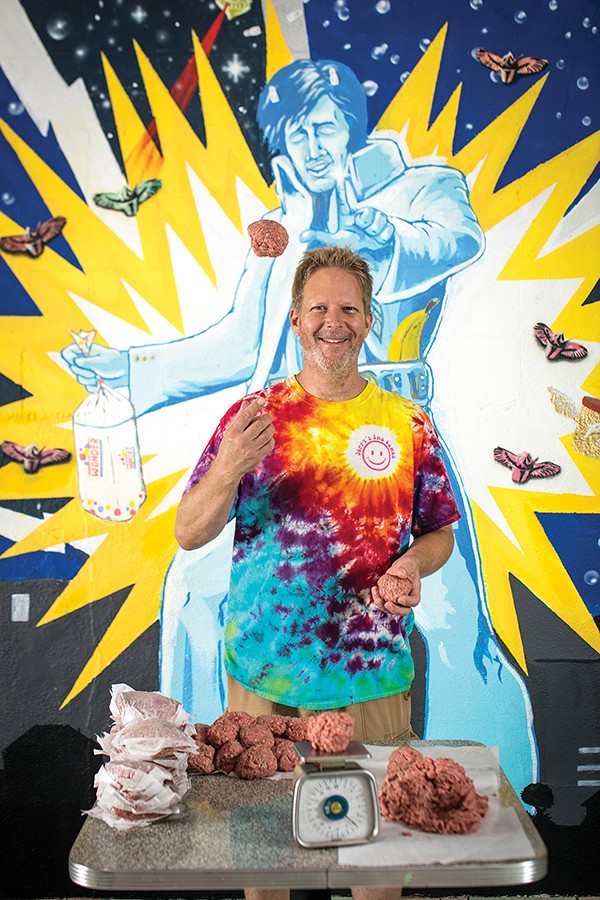 Justin Fox Burks
Justin Fox Burks
David Acklin of Jerry’s Sno Cones
Jerry’s Burger
Six days a week, David Acklin wakes up at 5 a.m. to begin his routine. He makes a few stops on his way to work. One at Superlo Foods for some ground beef, then to Easy Way for tomatoes and lettuce, to Sam’s Club for other supplies, and lastly to a couple of banks.
Then he drives to a small pink and green shack on Wells Station — better known as Jerry’s Sno Cones — to begin preparing for the day ahead.
Jerry’s is often known for its sno cones, but for the past eight or nine years, its burgers have begun making a name for themselves.
Acklin, owner of the 50-year-old dive, says the reason Jerry’s burgers have a reputation of being good is because he tries to make each burger like one he would make at home and as fresh as possible.
“I could pick up a frozen patty like everyone else, but we’re just not going to do that,” he says. “No two of our burgers are shaped the same — I promise you that.”
Each morning before Jerry’s opens for business, Acklin personally seasons the beef, forms them out one-by-one by hand, then weighs each one to be sure it is right at one-third of a pound.
He says although Jerry’s will sell about 250 burgers each day, he wants to keep it “old school” by having just one person cooking the burgers and another grilling butter-coated buns.
Jerry’s offers burgers with the basic accoutrements like cheese, lettuce, tomato, and mayo, as well as nine specialty burgers like one with pesto, one with chili and cole slaw, and another with teriyaki sauce and pineapple.
Each burger has a story, Acklin says. He enjoys recreating burgers that others were excited to tell him about or one from a special occasion, like the ’70s burger, topped with Swiss cheese, worcestershire sauce, and mushrooms, which is based on a burger Acklin’s sister told him she had on her first date.
One of Acklin’s goals for Jerry’s is to have a real contender for one of the top three burgers in the city.
“We don’t have to be No. 1,” he says. “Number two or three is good for me.”
— Maya Smith
Jerry’s Sno Cones, 1657 Wells Station, 767-2659, jerryssnowcones.com
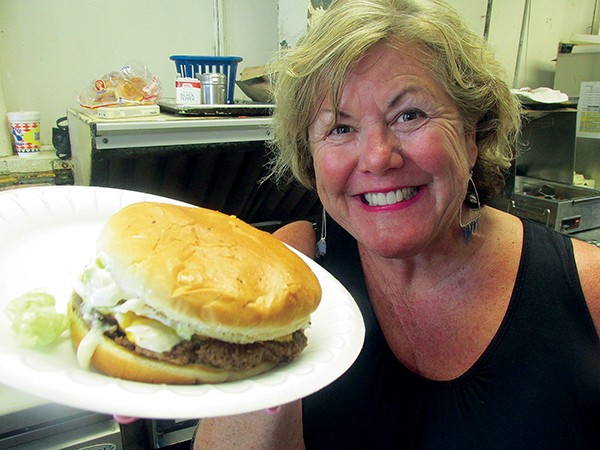
Tawanda Pirtle
Pirtle’s Burger
“No frills hamburger” is what Tawanda Pirtle calls the burgers sold at the eight locations of Jack Pirtle’s Chicken.
Pirtle, who owns the chain with her husband, Cordell, also refers to them as “American grilled,” “Southern grilled,” and “a very filling plain-old-fashioned grilled” hamburger. “Cheese, lettuce, tomato, onions, and pickles,” she says. “And mustard, mayonnaise, and ketchup, if you prefer.”
They’ve been selling hamburgers as long as they’ve been selling chicken, Pirtle says. “We’ve been doing hamburgers since we opened in 1957. Mr. Pirtle always believed you had to have a variety so your customers would eat with you every day.”
They use a “special seasoning” on the burgers, Pirtle says. “The seasoning we use is a seasoning Mr. Pirtle came up with himself. It’s a special Jack Pirtle’s seasoning.”
That seasoning accounts for the tastiness of the burger, says Pirtle, who wouldn’t divulge even a single ingredient. “Just a mixture of spices we call ‘good stuff.'”
The hamburgers are grilled on “just an old fashioned flat grill. And we toast our buns on the same grill.”
For a place that has the word “chicken” in its title, hamburgers are “very popular,” Pirtle says. “Our hamburgers are not as popular as our steak sandwich, but we’ve always sold a lot of our hamburgers.”
Has anyone ever ordered chicken on their hamburger? “We haven’t had that yet, but it’s not that we wouldn’t do that. Can you imagine having a burger and a couple of grilled tenders or fried tenders laid across it? That might be pretty tasty.” — MD
Jack Pirtle’s Chicken multiple locations, jackpirtleschicken.com
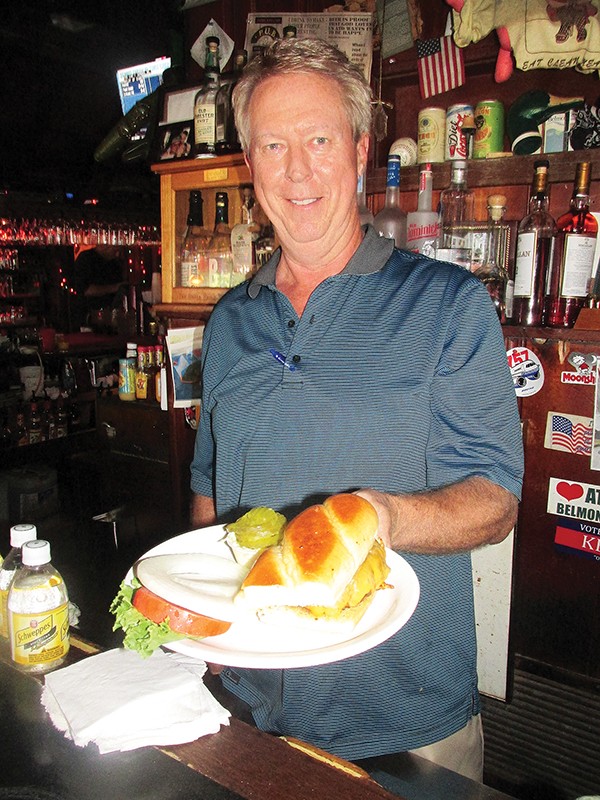
Belmont Burger
Belmont Burger
The Belmont Burger doesn’t look like a lot of hamburgers you see around town. It’s served on a French loaf instead of a hamburger bun, but it’s been a favorite of customers at Belmont Grill for decades.
They began serving the burger “when we took over The Belmont in 1984,” says manager/owner Jeff Anderson.
They began using the French loaf right away. “It’s always been done like that. It’s different than anything else that was out there at the time. Everybody had a burger, but it was totally different than what anybody had. So, that’s what made it unique. That’s how the popularity started. The French loaf and the sauce we put on it before we charbroil it.”
Anderson wouldn’t elaborate on that sauce. “We just call it the ‘black sauce.’ That’s as far as we go.”
As for the cooking method, Anderson says, “It’s cooked on a charbroiler. It’s just an open flame. The marinade definitely helps give it a unique taste. And the French loaf. It’s not a burger bun. You get a little more of a crispy bite to it.”
The Belmont Burger has “always been our No. 1 seller,” Anderson says. “We probably sell six times more than any other sandwich. In a day’s time, 50 to 100. It just depends.” — MD
Belmont Grill, 4970 Poplar, 767-0305
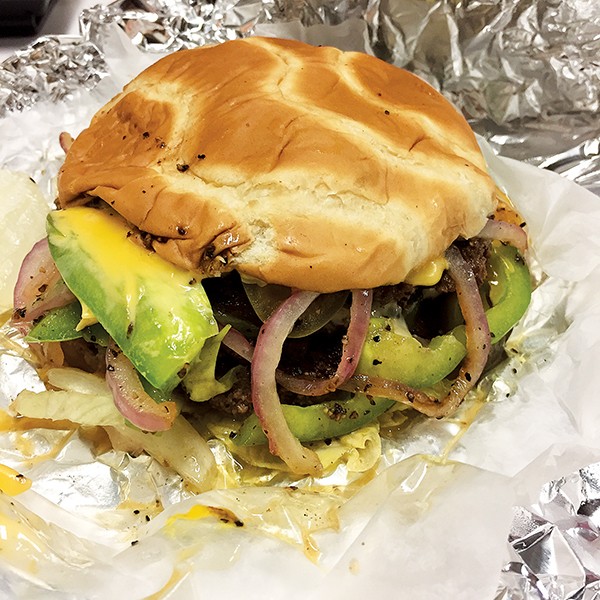
Roxie’s Burger
Roxie’s Burger
In May 2016, fire engines rushed to Roxie’s Grocery, the tiny Uptown market on Third Street. Local hamburger aficionados held their breath. When the store finally reopened, April 1, 2017, an oversized crowd showed up to welcome them back.
“We ran out of everything,” Keisha Edwards recalls, describing the happy chaos of opening day. “We ran out of cups. We even ran out of ground beef.”
Roxie’s is sometimes described as a “best kept secret,” although the sundry and kitchen where longtime regulars gather out front to sit on milk crates and shoot the breeze over cornbread and daily specials, has been serving the Uptown/Greenlaw neighborhood for 33 years. During that time, it’s earned a strong word-of-mouth reputation for dishing up tasty soul food and one of the biggest and best-dressed flat-top burgers in town.
“In the world,” Edwards corrects. Edwards, Roxie’s official historian, says the key to a good burger is love — and patience. “You’ve got to let it take as long as it takes,” she says. “You don’t want to rush it.”
Edwards personally recommends the Mr. Goodburger as her ideal of what the perfect burger should be. It ups the ante with two spicy, bun-challenging patties, bacon slices, and three different cheeses. “I want a burger that’s a complete meal,” she says.
— Chris Davis
Roxie’s Grocery, 520 N. 3rd, 525-2817
Memphis’ Most Iconic Hamburgers
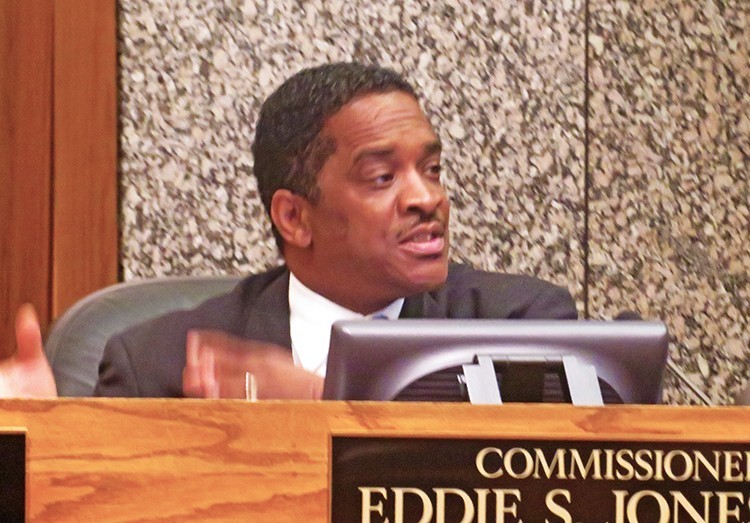 JB
JB 

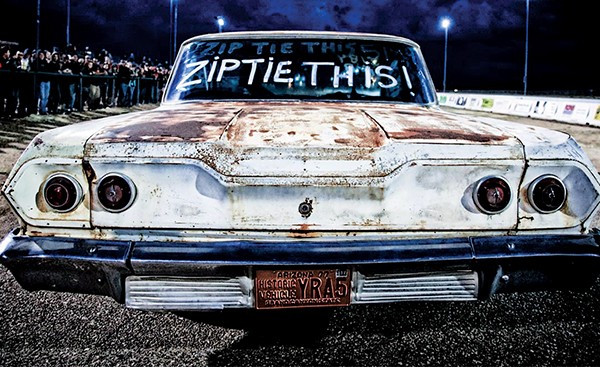

 Justin Fox Burks
Justin Fox Burks 
 Justin Fox Burks
Justin Fox Burks 


